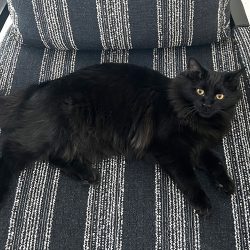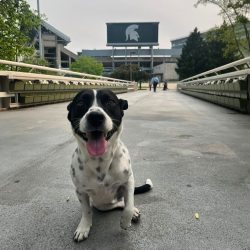History and Diagnosis

A 13-year-old Holsteiner gelding named Fender presented to the Large Animal Internal Medicine service at the MSU Veterinary Medical Center for evaluation of apparent abdominal discomfort and agitation. Fender’s owner, Julie Bass, was very concerned about his wellbeing. The night before hospital admission, Fender pawed relentlessly, ultimately excavating a hole in his stall floor. Discomfort was attributed to mild enteritis, but Fender failed to respond as expected to therapy. His attending veterinarian became concerned when pain persisted despite administration of nonsteroidal anti-inflammatory medications. He therefore referred Fender to the Veterinary Medical Center for further assessment.
At hospital admission, serum creatinine concentration was moderately elevated (2.4 mg/dL; reference range 0.9-1.8 mg/dL), but the horse was oliguric. The urinary tract was thoroughly evaluated using ultrasonography and cystoscopy. Renal size and echogenicity were normal bilaterally. The urethral and bladder mucosa appeared normal when visualized endoscopically; however, the bladder contained only 60 mL of urine. Urine specific gravity was 1.010 despite the estimated 30L fluid deficit predicted by his 5% degree of dehydration. Isosthenuria under these conditions was highly suggestive of renal insufficiency.
Although nonsteroidal anti-inflammatory drugs are well tolerated in the vast majority of horses, Fender had experienced an episode of rhabdomyolysis two years prior to his current illness. Residual kidney damage was mild, but sufficient renal function had been lost to render his kidneys susceptible to severe injury from the nonsteroidal anti-inflammatory medications he had received.
Treatment and Outcome
Intravenous crystalloid fluids were administered at a rate of 2 L/h to facilitate diuresis. Because Fender was oliguric, careful monitoring was necessary to prevent overhydration. Central venous pressure and body weight were therefore recorded every two hours. A urine collection device was also used to quantify urine output. Although Fender began to urinate 12 hours after hospital admission, urine volume remained low. Only 7 L of urine was produced during the first 24 hours of hospitalization, despite administration of 40 L of intravenous crystalloids. Concurrently, serum creatinine (7.3 mg/dL) and potassium (5.1 mmol/L; reference range 2.6-4.8 mmol/L) concentrations began to increase. A continuous intravenous infusion of furosemide was therefore initiated to prevent pulmonary edema and promote renal potassium excretion.
Over the next several days, Fender’s kidneys slowly recovered function and his normally playful personality returned. He was clearly feeling better. A week after admission to the hospital, Fender was well enough to return home.
Comments
Renal failure is not a common problem in adult horses. Due to its insidious onset, chronic renal disease often goes undetected until it is severe. In Fender’s case, even normal doses of nephrotoxic medications precipitated an acute, life-threatening crisis because of underlying mild renal insufficiency. Thanks to the expertise of MSU’s veterinarians and nursing staff, around-the-clock intensive care provided by the Veterinary Medical Center, and the dedication of his owners, Fender returned to his career as a successful show horse.



